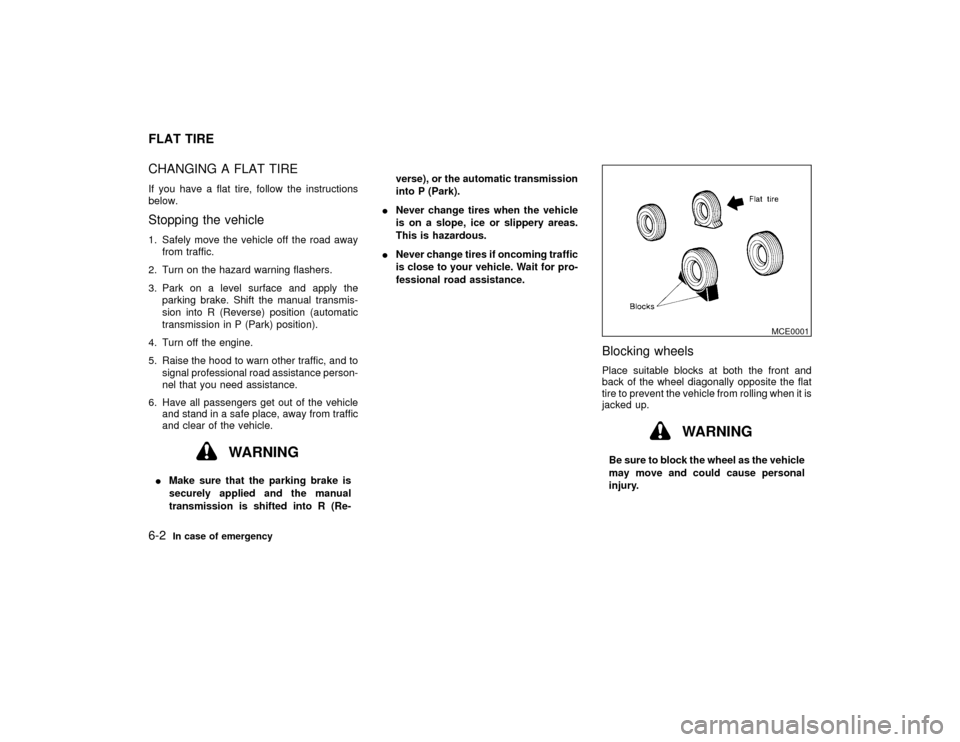2000 NISSAN MAXIMA manual transmission
[x] Cancel search: manual transmissionPage 145 of 239

CHANGING A FLAT TIREIf you have a flat tire, follow the instructions
below.Stopping the vehicle1. Safely move the vehicle off the road away
from traffic.
2. Turn on the hazard warning flashers.
3. Park on a level surface and apply the
parking brake. Shift the manual transmis-
sion into R (Reverse) position (automatic
transmission in P (Park) position).
4. Turn off the engine.
5. Raise the hood to warn other traffic, and to
signal professional road assistance person-
nel that you need assistance.
6. Have all passengers get out of the vehicle
and stand in a safe place, away from traffic
and clear of the vehicle.
WARNING
IMake sure that the parking brake is
securely applied and the manual
transmission is shifted into R (Re-verse), or the automatic transmission
into P (Park).
INever change tires when the vehicle
is on a slope, ice or slippery areas.
This is hazardous.
INever change tires if oncoming traffic
is close to your vehicle. Wait for pro-
fessional road assistance.
Blocking wheelsPlace suitable blocks at both the front and
back of the wheel diagonally opposite the flat
tire to prevent the vehicle from rolling when it is
jacked up.
WARNING
Be sure to block the wheel as the vehicle
may move and could cause personal
injury.
MCE0001
FLAT TIRE6-2
In case of emergency
Z
00.1.17/A33-D/V5.0
X
Page 155 of 239

CAUTION
IAlways release the parking brake
when towing with the rear wheels on
the ground.
IWhen towing manual transmission
models with the front wheels on the
ground (If you do not use a towing
dolly):
Turn the ignition key to the OFF posi-
tion, and secure the steering wheel in
a straight-ahead position with a rope
or similar device. Never place the
ignition key in the LOCK position.
This will result in damage to the
steering lock mechanism.
Move the gearshift lever to the N
(Neutral) position.
CAUTION
INever tow an automatic transmission
models with the front wheels on theground as this may cause serious
and expensive damage to the trans-
mission. If it is necessary to tow the
vehicle with the rear wheels raised,
always use a towing dollies under the
front wheels.
INever tow an automatic transmission
model from the rear (that is, back-
ward) with four wheels on the ground
as this may cause serious and expen-
sive damage to the transmission.
VEHICLE RECOVERY (Freeing a
stuck vehicle)ITow chains or cables must be attached only
to the main structural members of the ve-
hicle.
IPulling devices should be routed so they do
not touch any part of the suspension, steer-
ing, brake or cooling systems.
IAlways pull the cable straight out from the
front or rear of the vehicle. Never pull on the
vehicle at an angle.
IPulling devices such as ropes or canvas
straps are not recommended for use in
SCE0199
6-12
In case of emergency
Z
00.1.17/A33-D/V5.0
X
Page 165 of 239

When performing any inspection or mainte-
nance work on your vehicle, always take care
to prevent serious accidental injury to yourself
or damage to the vehicle. The following are
general precautions which should be closely
observed.
WARNING
IPark the vehicle on a level surface,
apply the parking brake securely and
block the wheels to prevent the ve-
hicle from moving. For a manual
transmission, move the shift lever to
N (Neutral) position. For an automatic
transmission, move the selector lever
to P (Park) position.
IBe sure the ignition key is OFF or
LOCK when performing any parts re-
placement or repairs.
IYour vehicle is equipped with an au-
tomatic engine cooling fan. It may
come on at any time without warning,
even if the ignition key is in the OFF
position and the engine is not run-
ning. To avoid injury, always discon-nect the negative battery cable before
working near the fan.
IIf you must work with the engine
running, keep your hands, clothing,
hair and tools away from moving
fans, belts and any other moving
parts.
IIt is advisable to secure or remove
any loose clothing and any jewelry,
such as rings, watches, etc. before
working on your vehicle.
IAlways wear eye protection when-
ever you work on your vehicle.
IIf you must run the engine in an
enclosed space such as a garage, be
sure there is proper ventilation for
exhaust gases to escape.
INever get under the vehicle while it is
supported only by a jack. If it is nec-
essary to work under the vehicle,
support it with safety stands.
IKeep smoking materials, flame and
sparks away from fuel and the bat-tery.
IOn gasoline engine models with the
Multiport Fuel Injection (MFI) System,
the fuel filter or fuel lines should be
serviced by a NISSAN dealer because
the fuel lines are under high pressure
even when the engine is off.
CAUTION
IDo not work under the hood while the
engine is hot. Turn off the engine and
wait until it cools down.
INever connect or disconnect either
the battery or any transistorized com-
ponent connector while the ignition
key is on.
INever leave the engine or the auto-
matic transmission related compo-
nent harness connector discon-
nected while the ignition key is on.
IAvoid direct contact with used engine
oil. Improperly disposed motor oil
MAINTENANCE PRECAUTIONS8-2
Do-it-yourself
Z
00.1.17/A33-D/V5.0
X
Page 211 of 239

The following are approximate capacities. The actual refill capacities may be a little different. When refilling, follow the procedure
instructed in the ª8. Do-it-yourselfº section to determine the proper refill capacity.
Capacity (Approximate)
Recommended
specifications US
measureImp
measureLiter
Fuel 18-1/2 gal 15-3/8 gal 70 Unleaded gasoline with an octane rating of at least 91 AKI (RON 96)*1
Engine oil*6
Drain and refill
With oil filter change 4-1/4 qt 3-1/2 qt 4.0IAPI Certification Mark*2, *3
IAPI grade SG/SH, Energy ConservingI&IIorAPIgrade SJ, Energy
Conserving*2, *3
IILSAC grade GF-I & GF-II*2, *3 Without oil filter change 3-7/8 qt 3-1/4 qt 3.7
Cooling system
With reservoir 8-1/8 qt 6-3/4 qt 7.7
Genuine NISSAN anti-freeze coolant or equivalent
Reservoir 3/4 qt 5/8 qt 0.7
Manual transmission gear oil Ð Ð Ð API GL-4, Viscosity SAE 75W-90 only
Automatic transmission fluid
Refill to the proper oil level according to the instructions
in the ª8. Do-it-yourselfº section.Nissan Matic ªDº (Continental U.S. and Alaska) or Canada NISSAN Auto-
matic Transmission Fluid*4
Power steering fluidGenuine Nissan PSFII or equivalent*8
Brake and clutch fluidGenuine Nissan Brake Fluid*5 or equivalent DOT 3 (US FMVSS No. 116)
Multi-purpose grease Ð Ð Ð NLGI No. 2 (Lithium soap base)
Air conditioning system refrigerant Ð Ð Ð HFC-134a (R-134a)*7
Air conditioning system lubricants Ð Ð ÐNissan A/C System Oil
Type S or exact equivalent
*1: For additional information, see later in this paragraph for fuel recommendation.
*2: For additional information, see later in this paragraph for engine oil and oil filter recommendation.
*3: For additional information, see later in this paragraph for recommended SAE viscosity number.
*4: Dexron
TMIII/Mercon
TM
or equivalent may also be used. Outside the continental United States and Alaska contact a NISSAN dealer for more information regarding
suitable fluids, including recommended brand(s) of Dexron
TMIII/Mercon
TM
automatic transmission fluid.
*5: Available in mainland US through your NISSAN dealer.
*6: For additional information, see ªEngine oilº in the ª8. Do-it-yourselfº section for changing engine oil.
*7: For additional information, see ªVehicle identificationº in this section for air conditioner specification label.
*8: Genuine Nissan PSFII, Canada Nissan Automatic Transmission fluid, Dexron
TMIII/Mercon
TM
or equivalent ATF may also be used.
CAPACITIES AND
RECOMMENDED
FUEL/LUBRICANTS10-2
Technical and consumer information
Z
00.1.17/A33-D/V5.0
X
Page 227 of 239

trailer is hitched. Do not drive the vehicle if
it has an abnormal nose-up or nose-down
condition; check for improper tongue load,
overload, worn suspension or other pos-
sible causes of either condition.
IAlways secure items in the trailer to prevent
load shifts while driving.
IBe certain your rear view mirrors conform to
all federal, state or local regulations. If not,
install any mirrors required for towing be-
fore driving the vehicle.
Trailer towing tipsIn order to gain skill and an understanding of
the vehicle's behavior, you should practice
turning, stopping and backing up in an area
which is free from traffic. Steering stability, and
braking performance will be somewhat differ-
ent than under normal driving conditions.
IAlways secure items in the trailer to prevent
load shift while driving.
IAvoid abrupt starts, acceleration or stops.
IAvoid sharp turns or lane changes.
IAlways drive your vehicle at a moderate
speed.
IAlways block the wheels on both vehicle
and trailer when parking. Parking on aslope is not recommended; however, if you
must do so, and if your vehicle is equipped
with automatic transmission, first block the
wheels and apply the parking brake, and
then move the transmission selector lever
into the P (Park) position. If you move the
selector lever to the P (Park) position be-
fore blocking the wheels and applying the
parking brake, transmission damage could
occur.
IWhen going down a hill, shift into a lower
gear and use the engine braking effect.
When ascending a long grade, downshift
the transmission to a lower gear and reduce
speed to reduce chances of engine over-
loading and/or overheating.
IIf the engine coolant rises to an extremely
high temperature when the air conditioning
system is on, turn off the air conditioner.
Coolant heat can be additionally vented by
opening the windows, switching the fan
control to high and setting the temperature
control to the HOT position.
ITrailer towing requires more fuel than nor-
mal circumstances.
IAvoid towing a trailer for the first 500 miles
(800 km).
IHave your vehicle serviced more often thanat intervals specified in the recommended
maintenance schedule.
IWhen making a turn, your trailer wheels will
be closer to the inside of the turn than your
vehicle wheels. To compensate for this,
make a larger than normal turning radius
during the turn.
ICrosswinds and rough roads will adversely
affect vehicle/trailer handling, possibly
causing vehicle sway. When being passed
by larger vehicles, be prepared for possible
changes in crosswinds that could affect
vehicle handling. If swaying does occur,
firmly grip the steering wheel, steer straight
ahead, and immediately (but gradually) re-
duce vehicle speed. This combination will
help stabilize the vehicle. Never increase
speed.
IBe careful when passing other vehicles.
Passing while towing a trailer requires con-
siderably more distance than normal pass-
ing. Remember the length of the trailer
must also pass the other vehicle before you
can safely change lanes.
ITo maintain engine braking efficiency and
electrical charging performance, do not use
fifth gear (manual transmission) or over-
drive (automatic transmission).10-18
Technical and consumer information
Z
00.1.17/A33-D/V5.0
X
Page 232 of 239

11 Index
A
ABS (Anti-lock brake system) ......................... 5-19
Air bag
Warning labels........................................... 1-18
Warning light ...................................... 1-19, 2-8
Air bag system
(See supplemental restraint system) ........ 1-13
Side (See supplemental side air bag
system) ...................................................... 1-15
Air cleaner housing filter ................................. 8-17
Air conditioner
Air conditioner operation ............................. 4-3
Air conditioner service ....................... 4-3, 4-11
Air conditioner specification label .... 4-3, 10-12
Air conditioner system refrigerant and
lubrication recommendations ...................... 4-3
Heater and air conditioner controls ............. 4-3
Servicing air conditioner .............................. 4-3
Air conditioning system refrigerant and lubricant
recommendations ........................................... 10-6
Air flow charts ................................................... 4-6
Alcohol, drugs and driving ................................ 5-4
AM-FM radio with cassette player .................. 4-12
AM-FM radio with cassette player and compact
disc player....................................................... 4-12
AM-FM radio with compact disc player .......... 4-12
Ambient temperature switch (AMB), Air
conditioner ...................................................... 4-11Anchor point locations, Top tether strap ........ 1-35
Antenna
Manual ....................................................... 4-24
Power ........................................................ 4-24
Anti-lock Brake System (ABS) ........................ 5-19
Anti-lock brake warning light............................. 2-9
Appearance care
Exterior appearance care ............................ 7-2
Interior appearance care ............................. 7-4
Armrest ............................................................. 1-8
Audio system .................................................. 4-12
Automatic
Automatic transmission fluid (ATF) ........... 8-10
Driving with automatic transmission............ 5-8
Sunroof ...................................................... 2-29
Transmission selector lever lock release .... 5-9
Avoiding collision and rollover .......................... 5-3
B
Battery............................................................. 8-13
Battery replacement, (See multi-remote control
system) ............................................................. 3-7
Battery, Battery saver system ........................ 2-18
Before starting the engine ................................ 5-7
Belts (See drive belts) .................................... 8-15
Brake
Anti-lock brake system (ABS) ................... 5-19Brake and clutch fluid................................ 8-12
Brake booster ............................................ 8-21
Brake pedal ............................................... 8-20
Brake pedal check..................................... 8-20
Parking brake check ........................ 5-13, 8-20
Parking brake operation ............................ 5-13
System....................................................... 5-18
Warning light ............................................... 2-9
Break-in schedule ........................................... 5-16
Bulb check/instrument panel ............................ 2-7
Bulb replacement ............................................ 8-25
C
Capacities and recommended
fuel/lubricants .................................................. 10-2
Car phone ....................................................... 4-25
Car phone or CB radio ................................... 4-25
Cassette player (See audio system) .............. 4-16
Cassette tape operation ................................. 4-12
Catalytic converter, Three way catalyst............ 5-3
Child restraints ................................................ 1-28
Installation on front passenger seat .......... 1-36
Installation on rear seat outboard or center
positions .................................................... 1-30
Precautions on child restraints .................. 1-28
Top tether strap anchor point locations .... 1-35
Child safety ..................................................... 1-22
Z
00.1.17/A33-D/V5.0
X
Page 233 of 239

Child safety rear door lock................................ 3-4
Chimes ............................................................ 2-11
Cigarette lighter (accessory) and ashtray....... 2-23
Circuit breaker, Fusible link ............................ 8-22
Cleaning exterior and interior .................... 7-2, 7-4
Clock ............................................................... 2-30
Clutch
Clutch pedal .............................................. 8-21
Fluid ........................................................... 8-12
Cold weather driving ....................................... 5-21
Compact Disc (CD) player (See audio
system) ........................................................... 4-23
Compact disc (CD) player operation .............. 4-12
Compact spare tire ......................................... 8-35
Console box .................................................... 2-26
Controls
Audio controls............................................ 4-12
Audio controls (rear).................................. 4-12
Audio controls (steering wheel)................. 4-12
Heater and air conditioner controls ............. 4-3
Heater and semiautomatic air
conditioner ................................................... 4-3
Coolant
Capacities and recommended fuel/
lubricants ................................................... 10-2
Changing engine coolant ............................ 8-6
Checking engine coolant level .................... 8-5
Corrosion protection ......................................... 7-5
Cruise control.................................................. 5-14
Cup holder ...................................................... 2-24D
Daytime running light system ......................... 2-19
Defogger switch, Rear window and outside mirror
defogger switch............................................... 2-16
Dimensions and weights ................................. 10-9
Door open warning light ................................... 2-8
Drive belts ....................................................... 8-15
Driving
Cold weather driving ................................. 5-21
Driving with automatic transmission............ 5-8
Driving with manual transmission ............. 5-11
Precautions when starting and driving ........ 5-2
E
Economy, Fuel ................................................ 5-16
Emission control information label ................ 10-11
Emission control system warranty ................ 10-20
Engine
Before starting the engine ........................... 5-7
Block heater .............................................. 5-22
Capacities and recommended fuel/
lubricants ................................................... 10-2
Changing engine coolant ............................ 8-6
Changing engine oil .................................... 8-8
Changing engine oil filter ............................ 8-9
Checking engine coolant level .................... 8-5
Checking engine oil level ............................ 8-7
Coolant temperature gauge ........................ 2-5
Engine compartment check locations ......... 8-4
Engine cooling system ................................ 8-5Engine oil..................................................... 8-7
Engine oil and oil filter recommendation... 10-5
Engine oil viscosity .................................... 10-5
Engine serial number .............................. 10-11
Engine specifications................................. 10-7
If your engine overheats ........................... 6-10
Starting the engine ...................................... 5-7
Exhaust gas (Carbon monoxide) ...................... 5-2
F
F.M.V.S.S. certification label......................... 10-11
Filter, Air cleaner housing filter ....................... 8-17
Flashers (See hazard warning flasher
switch) ............................................................. 2-20
Flat tire .............................................................. 6-2
Floor mat cleaning ............................................ 7-4
Fluid
Automatic transmission fluid (ATF) ........... 8-10
Brake and clutch fluid................................ 8-12
Capacities and recommended fuel/
lubricants ................................................... 10-2
Engine coolant............................................. 8-5
Engine oil..................................................... 8-7
Power steering fluid................................... 8-11
Window washer fluid ................................. 8-12
Fog light switch ............................................... 2-19
Front manual seat adjustment .......................... 1-2
Front power seat adjustment ............................ 1-4
Fuel
Capacities and recommended fuel/
lubricants ................................................... 10-2
Filler cap .................................................... 3-10
Z
00.1.17/A33-D/V5.0
X
11-2
Page 234 of 239

Filler lid ...................................................... 3-10
Filler lid and cap ........................................ 3-10
Filler lid opener lever................................. 3-10
Fuel economy ............................................ 5-16
Fuel octane rating ..................................... 10-3
Fuel recommendation................................ 10-3
Gauge .......................................................... 2-5
Fuses .............................................................. 8-21
Fusible links .................................................... 8-22
G
Garage door opener, Integrated HomeLink
Universal Transceiver ..................................... 2-33
Gas cap .......................................................... 3-10
Gauge ............................................................... 2-3
Engine coolant temperature gauge ............. 2-5
Fuel gauge .................................................. 2-5
Odometer..................................................... 2-4
Speedometer ............................................... 2-4
Tachometer ................................................. 2-4
General maintenance ................................ 9-2, 9-3
Glasses case .................................................. 2-24
Glove box........................................................ 2-25
Glove box lock ................................................ 2-25
H
Hazard warning flasher switch........................ 2-20
Head restraints ................................................. 1-7
Headlamps, (Bulb replacement) ..................... 8-26
Headlights, (Bulb replacement) ...................... 8-26Headlights, Headlight switch........................... 2-17
Heated seats................................................... 2-21
Heater
Engine coolant heater ............................... 5-22
Heater and air conditioner controls ............. 4-3
Heater operation.......................................... 4-3
Operation, Semiautomatic air conditioner ... 4-4
HomeLink
Universal Transceiver .................. 2-33
Hood, release ................................................... 3-8
Horn ................................................................ 2-20
How to stop alarm, Theft warning .................. 2-13
I
Ignition switch ................................................... 5-4
Automatic transmission models .................. 5-4
Key positions ............................................... 5-6
Manual transmission models....................... 5-5
Immobilizer system ......................................... 2-13
Indicator lights and chimes (See warning/indicator
lights and chimes) ............................................. 2-9
Inside mirror .................................................... 3-13
Inspection/maintenance (I/M) test................. 10-20
Instrument panel ............................................... 2-2
Integrated HomeLink
Universal
Transceiver ..................................................... 2-33
Interior and cargo light .................................... 2-30
Interior light ..................................................... 2-30
Interior light replacement ................................ 8-27J
Jump starting .................................................... 6-7
K
Keyless entry, (See multi-remote control
system) ............................................................. 3-4
Keys .................................................................. 3-2
L
Label, Air conditioner specification label ...... 10-12
Label, Emission control information label ..... 10-11
Label, F.M.V.S.S. certification label.............. 10-11
Labels
Air bag warning labels............................... 1-19
Air conditioner specification label................ 4-3
Engine serial number .............................. 10-11
Vehicle identification number (VIN)......... 10-10
License plate, Installing front license plate... 10-13
Light
Air bag warning light ................................. 1-18
Bulb replacement ...................................... 8-25
Fog light switch ......................................... 2-19
Headlamps (Bulb replacement)................. 8-26
Headlight switch ........................................ 2-17
Headlights (Bulb replacement) .................. 8-26
Interior and cargo light .............................. 2-30
Interior light................................................ 2-30
Personal light............................................. 2-31
Z
00.1.17/A33-D/V5.0
X
11-3